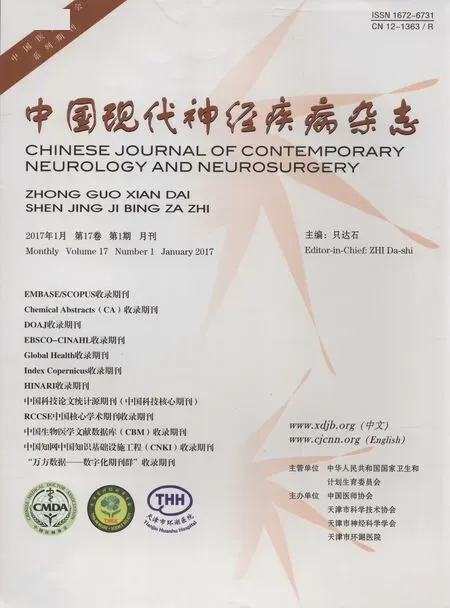應重視帕金森病認知功能障礙
張建蕓 陳彪 許二赫
·專題綜述·
應重視帕金森病認知功能障礙
張建蕓 陳彪 許二赫
認知功能障礙是帕金森病常見的非運動癥狀,影響患者生活質量、增加家屬負擔。帕金森病認知功能障礙包括帕金森病輕度認知損害和帕金森病癡呆。本文擬對國內外帕金森病認知功能障礙發病機制、臨床表現、診斷標準和藥物治療研究進展進行概述。
帕金森病;認知障礙;綜述
帕金森病(PD)是臨床常見的神經變性病,核心癥狀為運動遲緩、肌強直、靜止性震顫等運動癥狀,同時伴一系列非運動癥狀(NMS)如嗅覺障礙、睡眠障礙、認知功能障礙、自主神經功能障礙等[1],其中,認知功能障礙是最常見、最重要的非運動癥狀,可發生于帕金森病的任何階段,對患者生活質量和社會功能造成嚴重影響,同時增加照料者負擔,給家庭和社會帶來嚴重經濟負擔和心理負擔[2]。帕金森病認知功能障礙可以分為帕金森病輕度認知損害(PD-MCI)[3]和帕金森病癡呆(PDD)[4]。流行病學調查資料顯示,帕金森病癡呆發生率為24%~31%,有70%~80%的帕金森病患者最終進展為帕金森病癡呆,且以每年10%的速度進展[5]。本文擬對國內外帕金森病認知功能障礙發病機制、臨床表現、診斷標準與藥物治療方面的研究進展進行闡述,以期為早期識別和進一步了解帕金森病認知功能障礙提供參考。
一、帕金森病認知功能障礙發病機制
既往有學者對帕金森病患者進行尸體解剖,發現腦組織α-突觸核蛋白(α-Syn)沉積部位與病情嚴重程度有關[6-8]。研究顯示,α-Syn沉積于大腦皮質影響皮質神經元功能時即表現出認知功能障礙,皮質下神經核團投射至紋狀體、邊緣系統、中腦皮質的神經纖維缺失時也可導致認知功能障礙[9]。故認為帕金森病認知功能障礙與多種神經化學和神經病理學機制有關。
1.神經病理改變(1)路易小體(LB)相關病理改變:路易小體相關病理改變是帕金森病認知功能障礙進展的最重要因素。Mattila等[10]于2000年對45例帕金森病患者腦組織路易小體和tau蛋白進行檢測,首次證實大腦皮質廣泛存在與α-Syn相關的路易小體,尤以額葉和扣帶回顯著,同時發現其與非阿爾茨海默病樣病理改變引起的認知功能障礙程度相關。進一步研究顯示,α-Syn診斷帕金森病癡呆具有較高的靈敏度(91%)和特異度(90%)[11]。來自美國的一項多中心臨床研究顯示,872例帕金森病癡呆患者中157例存在路易小體相關病理改變,包括76例新皮質型、54例邊緣系統型、27例黑質為主型,進一步行多重線性回歸分析,新皮質型路易小體相關病理改變是帕金森病癡呆的獨立危險因素(OR=3.210,95%CI:1.780~5.810;P<0.01),此型患者認知功能下降速度最迅速、認知域損害最廣泛;邊緣系統型路易小體患者僅發生視空間能力障礙[12]。然而值得注意的是,并非所有尸檢發現大腦皮質路易小體的帕金森病患者均存在認知功能障礙。因此,路易小體相關病理改變與帕金森病認知功能障礙的關系尚待進一步深入研究。(2)阿爾茨海默病樣病理改變:阿爾茨海默病樣病理改變對帕金森病認知功能障礙起重要作用。多項研究顯示,帕金森病認知功能障礙患者可以同時存在路易小體相關和阿爾茨海默病樣病理改變[13-15]。Compta等[14]在56例經病理學證實的帕金森病患者(包括29例帕金森病癡呆患者)腦組織中檢測到β-淀粉樣蛋白(Aβ)、α-Syn、tau蛋白、路易小體和路易突起,進一步行Cox回歸分析,結果顯示,大腦皮質和紋狀體Aβ沉積、大腦皮質路易小體相關病理改變、tau蛋白分期均與帕金森病癡呆相關;路易小體相關和阿爾茨海默病樣病理改變共同為帕金森病癡呆最相關的病理學機制。來自英國的一項Meta分析顯示,路易小體相關和阿爾茨海默病樣病理改變共存是帕金森病癡呆最主要的神經退行性變,且大腦皮質Aβ沉積可以加速帕金森病癡呆進展[15]。提示阿爾茨海默病樣病理改變可能通過路易小體在帕金森病認知功能障礙中發揮作用。
2.神經化學改變(1)多巴胺及其受體缺失:fMRI研究顯示,執行功能障礙的帕金森病患者進行任務轉換和工作記憶測驗時額葉-紋狀體通路中前額葉皮質、紋狀體和丘腦神經活動減低[16]。亦有研究顯示,帕金森病患者進行物體轉換或Stroop色詞測驗(SCWT)時尾狀核多巴胺減少甚至消失[17]。Hall等[18]對帕金森病患者進行尸檢發現,中腦腹側被蓋區(VTA)多巴胺缺失患者易進展為帕金森病癡呆。PET顯像顯示,認知功能障礙特別是執行功能障礙的帕金森病患者,島葉多巴胺D2受體代謝降低,證實中腦-皮質通路多巴胺表達變化與帕金森病認知功能障礙有關[19]。因此認為,額葉-紋狀體通路、中腦-皮質通路多巴胺缺失可以導致帕金森病患者認知功能障礙,特別是執行功能障礙。(2)膽堿能神經缺失:帕金森病患者存在Meynert基底核(NBM)皮質下結構改變,有學者認為,上行膽堿能通路損害對進展為帕金森病癡呆有重要作用[20]。影像學研究顯示,帕金森病和帕金森病癡呆患者存在膽堿能神經缺失[21]。目前影像學技術尚無法直接顯示膽堿能神經元,僅能通過標記囊泡乙酰膽堿轉運體(VACh T)或乙酰膽堿酯酶(ACh E)間接反映膽堿能神經元。Kuhl等[22]采用囊泡乙酰膽堿轉運體對比劑123I-5-三丁基錫-3-苯基哌啶基-2-羥基萘(123I-IBVM)SPECT對帕金森病和帕金森病癡呆患者進行顯像,結果顯示,帕金森病不伴癡呆患者僅頂葉和枕葉皮質乙酰膽堿轉運體攝取減少,而帕金森病癡呆患者則出現廣泛性大腦皮質囊泡乙酰膽堿轉運體攝取減少。Hilker等[23]的研究顯示,帕金森病不伴癡呆患者大腦皮質乙酰膽堿酯酶水平下降(10.7%),而帕金森病癡呆患者下降得更顯著(29.7%,P<0.01)。(3)其他單胺類神經遞質缺失:去甲腎上腺素是一種興奮性神經遞質,主要由藍斑釋放,投射至海馬、扣帶回、新皮質,經氧化代謝、神經免疫作用維持機體正常行為和注意力、記憶力[24]。Buddhala等[25]對15例帕金森病認知功能障礙患者和6例性別和年齡相匹配的正常對照者進行尸體解剖,分別取8個部位腦組織(包括殼核、前扣帶回、額中回、頂下小葉、楔前葉、視覺相關皮質、海馬、杏仁核),采用高效液相色譜法(HPLC)檢測其神經遞質水平、酶聯免疫吸附試驗(ELISA)檢測神經遞質相關轉運蛋白水平,結果顯示,與對照組相比,帕金森病認知功能障礙患者上述8個腦區去甲腎上腺素表達水平明顯降低(均P<0.05),提示去甲腎上腺素能神經缺失可能是帕金森病認知功能障礙的發病機制之一。劉惠苗等[26]發現,情緒與5-羥色胺(5-HT)能系統有關,對輕中度帕金森病患者認知功能障礙具有一定影響。中縫背核B6/7神經元投射5-羥色胺纖維至紋狀體和大腦皮質、中縫中核B5/8神經元投射至大腦皮質和海馬。研究顯示,晚期帕金森病患者中縫中核B5/8區域5-羥色胺能神經元缺失而B6/7區域無缺失,且隨病情進展,5-羥色胺能神經變性以B5/8區域最為顯著[27]。
二、帕金森病認知功能障礙臨床特點
既往有學者認為,帕金森病晚期方出現認知功能障礙[6]。多項研究顯示,帕金森病早期即已存在輕度認知損害[28-31],其中一項來自英國的臨床研究采用簡易智能狀態檢查量表(MMSE)、倫敦塔測驗(TOL)和模式識別記憶測驗(PRM)評價159例早期帕金森病患者認知功能,結果顯示,帕金森病輕度認知損害發生率為35.85%(57/159),帕金森病癡呆發生率為8.18%(13/159)[31]。帕金森病認知功能障礙隨疾病進展而逐漸加重,Broeders等[32]對123例早期診斷為帕金森病的患者分別進行3和5年隨訪,基線帕金森病輕度認知損害發生率為34.96%(43/123),隨訪3年時為53.41%(47/88),隨訪5年時為50%(28/56),其中20例(26.32%,20/76)進展為帕金森病癡呆。
帕金森患者可表現出多種認知域損害,包括執行功能、記憶力、視空間能力等。Muslimovic等[29]認為,記憶障礙和執行功能障礙是帕金森病認知功能障礙的核心癥狀,且多項研究支持此觀點[33-34]。執行功能障礙主要表現在工作計劃、任務轉換、行為抑制等方面,詞語流暢性測驗(VFT)、威斯康辛卡片分類測驗(WCST)、SCWT評分減少。亦有研究顯示,部分帕金森病患者無執行功能障礙[35]。記憶力障礙主要表現為編碼和儲存功能障礙,亦可表現為線索回憶障礙。此外,帕金森病患者還可出現幻視,據統計,約70%的帕金森病癡呆患者存在幻視,且通常為具體鮮明的人、動物或物體[36],常出現在帕金森病晚期,是疾病進展的標記。
三、帕金森病認知功能障礙診斷標準
目前,臨床有多種帕金森病癡呆診斷標準。既往研究多采用美國精神障礙診斷與統計手冊第4版(DSM-Ⅳ)的診斷標準[11],以記憶障礙作為必備診斷條件的核心癥狀之一,與帕金森病認知功能障礙特征不符,其對帕金森病癡呆的診斷缺乏特異性。2007年,國際運動障礙學會(MDS)制定統一規范的帕金森病癡呆診斷標準,給予4個核心認知域同等權重地位,任意2個認知域損害即可明確診斷[3]。2011年,Martinez-Martin等[37]分別根據DSM-Ⅳ診斷標準和國際運動障礙學會診斷標準對290例帕金森病患者的認知功能進行評價,結果顯示,國際運動障礙學會制定的帕金森病癡呆診斷標準具有較高的敏感性。
帕金森病輕度認知損害是根據臨床表現、認知功能和日常生活活動能力(ADL)進行定義的一組綜合征。目前,國際通用的帕金森病輕度認知損害診斷標準由國際運動障礙學會制定并于2012年發表于Mov Disord[4],該項診斷標準不僅符合帕金森病早期認知功能障礙特征,且與帕金森病癡呆診斷標準具有較好的一致性。Goldman等[38]根據該項診斷標準對76例平均病程9.30年的帕金森病患者進行認知功能評價,分別以低于正常參考值1、1.50、2、 2.50個標準差(SD)作為診斷界值并計算敏感性、特異性、陽性預測值、陰性預測值,結果顯示,以低于正常參考值2個標準差作為診斷界值具有最佳靈敏度(85.4%)和特異度(78.6%)。
四、藥物治療
膽堿能系統在帕金森病認知功能障礙中的重要作用體現在目前的治療藥物主要是膽堿酯酶抑制劑,如卡巴拉汀、多奈哌齊、加蘭他敏等。大規模臨床藥物試驗結果顯示,卡巴拉汀可以顯著改善帕金森病認知功能障礙之注意力障礙[39]。亦有研究顯示,膽堿酯酶抑制劑可以改善帕金森病患者執行功能、視空間能力和幻視[40]。Weintraub等[41]的研究顯示,膽堿酯酶抑制劑改善帕金森病認知功能障礙的效果優于阿爾茨海默病。此外,還有其他藥物可以改善帕金森病認知功能障礙但效果有限,如左旋多巴、N-甲基-D-天冬氨酸(NMDA)受體阻斷劑美金剛、去甲腎上腺素能再攝取抑制劑(NRI)阿托西汀等。
綜上所述,帕金森病認知功能障礙發病機制復雜,伴隨臨床對帕金森病及其相關并發癥的重視,帕金森病認知功能障礙逐漸成為國內外研究的焦點,了解其發病機制有助于臨床醫師更好地認識疾病,為全面研發改善帕金森病認知功能障礙的藥物和疾病修飾治療提供基礎。
[1]Qin ZH,Chan P,Zhang LY,Fan WH,Sun F,Liu HJ,Fang XH,Ding H,Meng C,Caroline Tanner.Study on non-motor symptoms impacting on health related quality of life in early Parkinson disease:randomized controlled clinical trial. Zhongguo Xian Dai Shen Jing Ji Bing Za Zhi,2009,9:246-251.[秦朝暉,陳彪,張麗燕,樊文輝,孫菲,劉宏軍,方向華,丁暉,孟琛,Caroline Tanner.早期帕金森病患者非運動性癥狀與健康相關生活質量的研究:隨機對照臨床試驗.中國現代神經疾病雜志,2009,9:246-251.]
[2]Li SH,Chen HB.Mild cognitive impairment in Parkinson's disease.Zhongguo Xian Dai Shen Jing Ji Bing Za Zhi,2016,16:319-323[.李淑華,陳海波.帕金森病輕度認知損害.中國現代神經疾病雜志,2016,16:319-323.]
[3]Williams-Gray CH,Foltynie T,Brayne CE,Robbins TW, Barker RA.Evolution of cognitive dysfunction in an incident Parkinson's disease cohort.Brain,2007,130(Pt 7):1787-1798.
[4]Litvan I,Goldman JG,Tr?ster AI,Schmand BA,Weintraub D, Petersen RC,Mollenhauer B,Adler CH,Marder K,Williams-Gray CH,Aarsland D,Kulisevsky J,Rodriguez-Oroz MC,Burn DJ,Barker RA,Emre M.Diagnostic criteria for mild cognitive impairment in Parkinson's disease:Movement Disorder Society Task Force guidelines.Mov Disord,2012,27:349-356.
[5]Aarsland D,Zaccai J,Brayne C.A systematic review of prevalence studies of dementia in Parkinson's disease.Mov Disord,2005,20:1255-1263.
[6]Braak H,Del Tredici K,Rüb U,de Vos RA,Jansen Steur EN, Braak E.Staging of brain pathology related to sporadic Parkinson's disease.Neurobiol Aging,2003,24:197-211.
[7]Bohnen NI,Albin RL.The cholinergic system and Parkinson disease.Behav Brain Res,2011,221:564-573.
[8]Gesi M,Soldani P,Giorgi FS,Santinami A,Bonaccorsi I, Fornai F.The role of the locus coeruleus in the development of Parkinson's disease.Neurosci Biobehav Rev,2000,24:655-668.
[9]Halliday GM,Leverenz JB,Schneider JS,Adler CH.The neurobiological basis of cognitive impairment in Parkinson's disease.Mov Disord,2014,29:634-650.
[10]Mattila PM,Rinne JO,Helenius H,Dickson DW,R?ytt? M. Alpha-synuclein-immunoreactive cortical Lewy bodies are associated with cognitive impairment in Parkinson's disease. Acta Neuropathol,2000,100:285-290.
[11]Hurtig HI,Trojanowski JQ,Galvin J,Ewbank D,Schmidt ML, Lee VM,Clark CM,Glosser G,Stern MB,Gollomp SM,Arnold SE.Alpha-synuclein cortical Lewy bodies correlate with dementia in Parkinson's disease.Neurology,2000,54:1916-1921.
[12]Schneider JA,Arvanitakis Z,Yu L,Boyle PA,Leurgans SE, Bennett DA.Cognitive impairment,decline and fluctuations in older community-dwelling subjects with Lewy bodies.Brain, 2012,135(Pt 10):3005-3014.
[13]Lashley T,Holton JL,Gray E,Kirkham K,O'Sullivan SS, Hilbig A,Wood NW,Lees AJ,Revesz T.Cortical α-synuclein load is associated with amyloid-β plaque burden in a subset of Parkinson's disease patients.Acta Neuropathol,2008,115:417-425.
[14]Compta Y,Parkkinen L,O'Sullivan SS,Vandrovcova J,Holton JL,Collins C,Lashley T,Kallis C,Williams DR,de Silva R, Lees AJ,Revesz T.Lewy-and Alzheimer-type pathologies in Parkinson's disease dementia:which is more important?Brain, 2011,134(Pt 5):1493-1505.
[15]Compta Y,Parkkinen L,Kempster P,Selikhova M,Lashley T, Holton JL,Lees AJ,Revesz T.The significance of α-synuclein, amyloid-βand tau pathologies in Parkinson's disease progression and related dementia.Neurodegener Dis,2014,13 (2/3):154-156.
[16]Au WL,Zhou J,Palmes P,Sitoh YY,Tan LC,Rajapakse JC. Levodopa and the feedback process on set-shifting in Parkinson's disease.Hum Brain Mapp,2012,33:27-39.
[17]Brück A,Portin R,Lindell A,Laihinen A,Bergman J, Haaparanta M,Solin O,Rinne JO.Positron emission tomography shows that impaired frontal lobe functioning in Parkinson's disease is related to dopaminergic hypofunction in the caudate nucleus.Neurosci Lett,2001,311:81-84.
[18]Hall H,Reyes S,Landeck N,Bye C,Leanza G,Double K, Thompson L,Halliday G,Kirik D.Hippocampal Lewy pathology and cholinergic dysfunction are associated with dementia in Parkinson's disease.Brain,2014,137(Pt 9):2493-2508.
[19]Christopher L,Marras C,Duff-Canning S,Koshimori Y,Chen R,Boileau I,Segura B,Monchi O,Lang AE,Rusjan P,Houle S,Strafella AP.Combined insular and striatal dopamine dysfunction are associated with executive deficits in Parkinson's disease with mild cognitive impairment.Brain,2014,137(Pt 2):565-575.
[20]Gratwicke J,Kahan J,Zrinzo L,Hariz M,Limousin P,Foltynie T,Jahanshahi M.The nucleus basalis of Meynert:a new target for deep brain stimulation in dementia?Neurosci Biobehav Rev, 2013,37(10 Pt 2):2676-2688.
[21]Silbert LC,Kaye J.Neuroimaging and cognition in Parkinson's disease dementia.Brain Pathol,2010,20:646-653.
[22]Kuhl DE,Minoshima S,Fessler JA,Frey KA,Foster NL,Ficaro EP,Wieland DM,Koeppe RA.In vivo mapping of cholinergic terminals in normal aging,Alzheimer's disease,and Parkinson's disease.Ann Neurol,1996,40:399-410.
[23]Hilker R,Thomas AV,Klein JC,Weisenbach S,Kalbe E, Burghaus L,Jacobs AH,Herholz K,Heiss WD.Dementia in Parkinson disease:functional imaging of cholinergic and dopaminergic pathways.Neurology,2005,65:1716-1722.
[24]Berridge CW,Waterhouse BD.The locus coeruleusnoradrenergic system:modulation of behavioral state and statedependent cognitive processes.Brain Res Brain Res Rev,2003, 42:33-84.
[25]Buddhala C,Loftin SK,Kuley BM,Cairns NJ,Campbell MC, Perlmutter JS,Kotzbauer PT.Dopaminergic,serotonergic,and noradrenergic deficits in Parkinson disease.Ann Clin Transl Neurol,2015,2:949-959.
[26]Liu HM,Li D,Qiu FC,Dong C,Zhang YZ,Han R,Xie BC,Gu P.Effect of emotion on the cognitive function of patients with mild to moderate Parkinson's disease.Zhongguo Xian Dai Shen Jing Ji Bing Za Zhi,2016,16:92-97[.劉惠苗,李冬,仇福成,董慈,張永志,韓瑞,解冰川,顧平.情緒對輕中度帕金森病患者認知功能的影響,中國現代神經疾病雜志,2016,16:92-97.]
[27]Halliday GM,Li YW,Blumbergs PC,Joh TH,Cotton RG, Howe PR,Blessing WW,Geffen LB.Neuropathology of immunohistochemically identified brainstem neurons in Parkinson's disease.Ann Neurol,1990,27:373-385.
[28]Broeders M,Velseboer DC,de Bie R,Speelman JD,Muslimovic D,Post B,de Haan R,Schmand B.Cognitive change in newlydiagnosed patients with Parkinson's disease:a 5-year follow-up study.J Int Neuropsychol Soc,2013,19:695-708.
[29]Muslimovic D,Post B,Speelman JD,Schmand B.Cognitive profile of patients with newly diagnosed Parkinson disease. Neurology,2005,65:1239-1245.
[30]Miah IP,Olde Dubbelink KT,Stoffers D,Deijen JB,Berendse HW.Early-stage cognitive impairment in Parkinson's disease and the influence of dopamine replacement therapy.Eur J Neurol,2012,19:510-516.
[31]Foltynie T,Brayne CE,Robbins TW,Barker RA.The cognitive ability of an incident cohort of Parkinson's patients in the UK:the Cam Pa IGN study.Brain,2004,127(Pt 3):550-560.
[32]Broeders M,de Bie RM,Velseboer DC,Speelman JD, Muslimovic D,Schmand B.Evolution of mild cognitive impairment in Parkinson disease.Neurology,2013,81:346-352.
[33]Caviness JN,Driver-Dunckley E,Connor DJ,Sabbagh MN, Hentz JG,Noble B,Evidente VG,Shill HA,Adler CH. Defining mild cognitive impairment in Parkinson's disease.Mov Disord,2007,22:1272-1277.
[34]Das D,Biswas A,Roy A,Sauerbier A,Bhattacharyya KB. Cognitive impairment in idiopathic Parkinson's disease.Neurol India,2016,64:419-427.
[35]Fournet N,Moreaud O,Roulin JL,Naegele B,Pellat J.Working memory in medicated patients with Parkinson's disease:the central executive seems to work.J Neurol Neurosurg Psychiatry, 1996,60:313-317.
[36]Barnes J,David AS.Visual hallucinations in Parkinson's disease:a review and phenomenological survey.J Neurol Neurosurg Psychiatry,2001,70:727-733.
[37]Martinez-Martin P,Falup-Pecurariu C,Rodriguez-Blazquez C, Serrano-Due?as M,Carod Artal FJ,Rojo Abuin JM,Aarsland D.Dementia associated with Parkinson's disease:applying the Movement Disorder Society Task Force criteria.Parkinsonism Relat Disord,2011,17:621-624.
[38]Goldman JG,Holden S,Bernard B,Ouyang B,Goetz CG, Stebbins GT.Defining optimal cutoff scores for cognitive impairment using Movement Disorder Society Task Force criteria for mild cognitive impairment in Parkinson's disease. Mov Disord,2013,28:1972-1979.
[39]Emre M,Aarsland D,Albanese A,Byrne EJ,Deuschl G,De Deyn PP,Durif F,Kulisevsky J,van Laar T,Lees A,Poewe W, Robillard A,Rosa MM,Wolters E,Quarg P,Tekin S,Lane R. Rivastigmine for dementia associated with Parkinson's disease. N Engl J Med,2005,351:2509-2518.
[40]Rolinski M,Fox C,Maidment I,McShane R.Cholinesterase inhibitors for dementia with Lewy bodies,Parkinson's disease dementia and cognitive impairment in Parkinson's disease. Cochrane Database Syst Rev,2012,(3):CD006504.
[41]Weintraub D,Somogyi M,Meng X.Rivastigmine in Alzheimer's disease and Parkinson's disease dementia:an ADAS-cog factor analysis.Am J Alzheimers Dis Other Demen,2011,26:443-449.
Attention must be paid to cognitive dysfunction in Parkinson's disease
ZHANG Jian-yun,CHAN Piu,XU Er-he
Department of Neurology,Xuanwu Hospital,Capital Medical University,Beijing 100053,China Corresponding author:XU Er-he(Email:xuerhe@163.com)
Cognitive dysfunction is one of the common non-motor symptoms(NMS)in Parkinson's disease(PD),which affects patients'life quality and increases the burden of caregivers.Cognitive dysfunction in PD can be divided into two parts,which are mild cognitive impairment(MCI)and dementia. This article aims to provide an overview on pathogenesis,clinical manifestations,diagnostic criteria and pharmacotherapy of PD both at home and abroad.
Parkinson disease;Cognition disorders;Review
2016-11-25)
10.3969/j.issn.1672-6731.2017.01.003
100053 北京,首都醫科大學宣武醫院神經內科
許二赫(Emai: xuerhe@ 163.com)

